| Atlas family | |
|---|---|
 Atlas II, III and V comparison Atlas II, III and V comparison | |
| General information | |
| Type | Expendable launch system with various applications |
| Manufacturer | Convair General Dynamics Lockheed Martin United Launch Alliance |
| Status | Atlas V (current) |
| Primary users | United States Air Force National Aeronautics and Space Administration |
| History | |
| Manufactured | 1957–2010s (decade) |
| Introduction date | 1957 |
| First flight | December 17, 1957; 67 years ago (1957-12-17) |
| Variants | SM-65 Atlas SM-65D Atlas Atlas LV-3C Atlas IIIA Atlas V |
Atlas is a family of US missiles and space launch vehicles that originated with the SM-65 Atlas. The Atlas intercontinental ballistic missile (ICBM) program was initiated in the late 1950s under the Convair Division of General Dynamics. Atlas was a liquid propellant rocket burning RP-1 kerosene fuel with liquid oxygen in three engines configured in an unusual "stage-and-a-half" or "parallel staging" design: two outboard booster engines were jettisoned along with supporting structures during ascent, while the center sustainer engine, propellant tanks and other structural elements remained connected through propellant depletion and engine shutdown.
The Atlas name was originally proposed by Karel Bossart and his design team working at Convair on project MX-1593. Using the name of a mighty Titan from Greek mythology reflected the missile's place as the biggest and most powerful at the time. It also reflected the parent company of Convair, the Atlas Corporation.
The missiles saw only brief ICBM service, and the last squadron was taken off operational alert in 1965. However, from 1962 to 1963 Atlas boosters launched the first four US astronauts to orbit the Earth (in contrast to the preceding two Redstone suborbital launches). The Atlas-Agena and Atlas-Centaur satellite launch vehicles were also derived directly from the original Atlas. The Atlas-Centaur was evolved into the Atlas II, various models of which were launched 63 times between 1991 and 2004. There were only six launches of the succeeding Atlas III, all between 2000 and 2005. The Atlas V is still in service, with launches planned into the mid 2020s.
More than 300 Atlas launches have been conducted from Cape Canaveral Space Force Station in Florida and 285 from Vandenberg Space Force Base in California.
Launch vehicles based on original Atlas ICBM
The Atlas was used as an expendable launch system, with both the Agena and Centaur upper stages, for the Mariner space probes used to explore Mercury, Venus, and Mars (1962–1973); and to launch ten of the Mercury program missions (1962–1963).
SM-65 Atlas missile
Main article: SM-65 AtlasThe first successful test launch of an SM-65 Atlas missile was on 17 December 1957. Approximately 350 Atlas missiles were built.
The Atlas boosters would collapse under their own weight if not kept pressurized with nitrogen gas in the tanks when devoid of propellants. The Atlas booster was unusual in its use of "balloon" tanks. The rockets were made from very thin stainless steel that offered minimal or no rigid support. It was pressure in the tanks that gave the rigidity required for space flight. In order to save weight they were not painted and needed a specially designed oil to prevent rust. This was the original use of WD-40 water displacement oil.
The SM-65 Atlas was used as a first stage for satellite launch vehicles for half a century. Many were eventually converted to orbital launch vehicles after they were removed from service as missiles. Missiles converted into Atlas E/F "space boosters" were used to launch the early "Block I" GPS satellites.
SM-65B Atlas SCORE launch
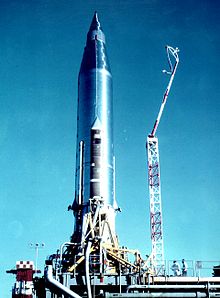
Early Atlas rockets were also built specifically for non-military uses. On 18 December 1958, an Atlas was used to launch the Signal Communication by Orbiting Relay Equipment (SCORE) satellite, which was "the first prototype of a communications satellite, and the first test of any satellite for direct practical applications." The communications payload was placed into low Earth orbit on Atlas serial number 10B without an upper stage. Atlas 10B/SCORE, at 8,750 lb (3,970 kg) was the heaviest artificial object then in orbit, the first voice relay satellite, and the first human-made object in space easily visible to the naked eye due to the large, mirror-polished stainless steel tank. This was the first flight in what would be a long career for the Atlas as a satellite launcher.
Atlas-D based launchers
Main article: Atlas SLV-3Atlas D missile-derived SLV-3s were used for orbital launches with the RM-81 Agena and Centaur upper stages. The modified Atlas LV-3B was used for the orbital element of Project Mercury, launching four crewed Mercury spacecraft into low Earth orbit. Atlas D launches were conducted from Cape Canaveral Air Force Station, at Launch Complexes 11, 12, 13 and 14, and Vandenberg AFB Launch Complex 576.
Two suborbital stage and a half vehicles were used during Project FIRE as sounding rockets.
By 1979, Atlas space launcher variants had been whittled down to just the Atlas-Centaur and some refurbished ICBMs. The launch rate of Atlases decreased in the 1980s due to the advent of the Space Shuttle, but Atlas launches continued until 2004, when the last "classic" Atlas with balloon tanks and the jettisonable booster section launched a comsat for the Air Force.
Mercury program

Atlas boosters were also used for the last four crewed Project Mercury missions, the first United States crewed space program. On February 20, 1962, it launched Friendship 7, which made three Earth orbits carrying John Glenn, the first United States astronaut to orbit the Earth. Identical Atlas boosters successfully launched three more crewed Mercury orbital missions from 1962 to 1963.
Atlas saw the beginnings of its "workhorse" status during the Mercury-Atlas missions, which resulted in Lt. Col. John H. Glenn Jr. becoming the first American to orbit the Earth in 1962. Atlas was also used throughout the mid-1960s to launch the Agena Target Vehicles used during the Gemini program.
Atlas-Agena
Main article: Atlas-AgenaBeginning in 1960, the Agena upper stage, powered by hypergolic propellant, was used extensively on Atlas launch vehicles. The United States Air Force, NRO and CIA used them to launch SIGINT satellites. NASA used them in the Ranger program to obtain the first close-up images of the surface of the Moon and for Mariner 2, the first spacecraft to fly by another planet. Each of the Agena target vehicles used for the later space rendezvous practice missions of Gemini was launched on an Atlas rocket.
Atlas-Centaur
Main article: Atlas-CentaurThe Atlas-Centaur was an expendable launch system derived from the SM-65D Atlas missile. Launches were conducted from two pads of the Launch Complex 36 at Cape Canaveral Air Force Station, Florida. The Atlas' engines were upgraded and the structure reinforced for the large upper stage, along with elongated propellant tanks.
The first launch attempt of an Atlas-Centaur in May 1962 failed, the rocket exploding after take-off. Footage of this was shown in the penultimate shot of the 1982 art film Koyaanisqatsi, directed by Godfrey Reggio.
Beginning in 1963, the liquid hydrogen-fueled Centaur upper stage was also used on dozens of Atlas launches. NASA launched the Surveyor program lunar lander spacecraft and most of the Mars-bound Mariner program spacecraft with Atlas-Centaur launch vehicles.
Atlas E/F
Main article: Atlas E/FFollowing retirement as an ICBM, the Atlas-E, along with the Atlas-F, were refurbished for orbital launches.
The last Atlas E/F spacecraft launch was conducted on 24 March 1995, using a rocket which had originally been built as an Atlas-E. The last Atlas E/F launch to use a rocket which had originally been built as an Atlas-F was conducted on 23 June 1981.
Atlas E/F was used to launch the Block I series of GPS satellites from 1978 to 1985. The last refurbished Atlas-F vehicle was launched from Vandenberg AFB in 1995 carrying a satellite for the Defense Meteorological Satellite Program.
Tabulated
| Model name | First launch | Last launch | Total launches | Successes | ICBM base | Upper stage | Notable payloads | Remarks |
|---|---|---|---|---|---|---|---|---|
| Atlas-Vega | - | - | 0 | 0 | Atlas E | storable propellant stage | none | Development was essentially identical to Atlas-Agena, and cancelled accordingly in 1959 |
| Atlas-Able | 1959 | 1960 | 3 | 0 | Atlas-D/Able(Delta-A) | Altair | Pioneer P-3, Pioneer P-30, Pioneer P-31 |  |
| Atlas LV-3A | 1960 | 1968 | 49 | 38 | Atlas D | Agena | Mariner 2, Ranger program, Missile Defense Alarm System |  |
| Atlas LV-3B | 1959 | 1963 | 9 | 9 | Atlas D | none | Friendship 7, Aurora 7, Sigma 7, Faith 7 | 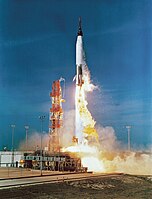 |
| Atlas SLV-3 | 1964 | 1968 | 51 | 46 | Atlas D | Agena | Corona, KH-7 Gambit | same as LV-3A except reliability improvements |
| Atlas SLV-3A | 1969 | 1978 | 10 | 9 | Atlas D | Agena | Canyon | same as SLV-3 except stretched 9.7 ft (2.97 m) |
| Atlas SLV-3B | 1966 | 1966 | 1 | 1 | Atlas D | Agena D | Orbiting Astronomical Observatory 1 | |
| Atlas LV-3C | 1963 | 1967 | 11 | 8 | Atlas D | Centaur C | Surveyor 1 |  |
| Atlas SLV-3C | 1967 | 1972 | 17 | 14 | Atlas D | Centaur D | ? | Same as LV-3C stretched 4.3 ft (1.3 m) |
| Atlas SLV-3D | 1973 | 1983 | 32 | 29 | Atlas D | Centaur D1A | Mariner 10 | 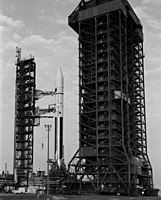 |
| Atlas G | 1984 | 1987 | 6 | 4 | Atlas G | Centaur D1A | ? |  |
| Atlas I | 1990 | 1997 | 11 | 8 | Atlas G derived | Centaur D1A derived | CRRES |  |
| Atlas II | 1991 | 1998 | 10 | 10 | Atlas G derived | Centaur D1A derived | Eutelsat | 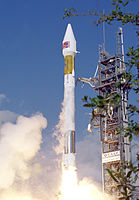 |
| Atlas IIA | 1992 | 2002 | 23 | 23 | Atlas G derived | Centaur D1A derived | - | Same as Atlas II except Centaur RL10 engines uprated to 20,000 lbf (88 kN) of thrust and 6.5-second Isp increase from extendible RL10 nozzles |
| Atlas IIAS | 1993 | 2004 | 30 | 30 | Atlas G derived | Centaur D1A derived | - | Same as Atlas IIA except four Castor IVA strap-on boosters added |
| Atlas D-OV1 | 1965 | 1967 | 7 | 6 | Atlas D | none | OV (Orbiting Vehicle) flights | |
| Atlas E | 1980 | 1995 | 23 | 21 | Atlas E | none |  | |
| Atlas F | 1968 | 1981 | 23 | 22 | Atlas F | none | ? | ICBM refurbished for orbital launch |
| Atlas H | 1983 | 1987 | 5 | 5 | Modified Atlas G | Centaur stage removed | NOSS satellites |  |
RD-180 era
Atlas III
The first stage of the Atlas III discontinued the use of three engines and 1.5 staging in favor of a single Russian-built Energomash RD-180 engine, while retaining the stage's balloon tank construction. The Atlas III continued to use the Centaur upper stage, available with single or dual RL10 engines.
Atlas V
Main article: Atlas V Launch of an Atlas V 401 carrying the LRO and LCROSS
Launch of an Atlas V 401 carrying the LRO and LCROSS
The Atlas V, currently in service, was developed by Lockheed Martin as part of the US Air Force Evolved Expendable Launch Vehicle (EELV) program. The first was launched on August 21, 2002. In 2006, operation was transferred to United Launch Alliance (ULA), a joint venture between Lockheed Martin and Boeing. Lockheed Martin continued to market the Atlas V to commercial customers until September 2021, when it announced that the rocket will be retired after fulfilling the remaining 29 launch contracts. Atlas V is built in Decatur, Alabama, and maintains two launch sites: Space Launch Complex 41 at Cape Canaveral Space Force Station and Space Launch Complex 3-E at Vandenberg Space Force Base.
The Atlas V's first stage is called the Common Core Booster (CCB), which continues to use the Energomash RD-180 introduced in the Atlas III, but employs a rigid framework instead of balloon tanks. The rigid fuselage is heavier, but easier to handle and transport, eliminating the need for constant internal pressure. Up to five Aerojet Rocketdyne strap-on solid rocket boosters can be used to augment first stage thrust. The upper stage remains the Centaur, powered by a single or dual Aerojet Rocketdyne RL10 engines.
| Model name | First launch | Last launch | Total launches | Successes | 1st-stage engines | Upper-stage engines | Notable payloads | Remarks |
|---|---|---|---|---|---|---|---|---|
| Atlas IIIA | 2000 | 2004 | 2 | 2 | 1xRD-180 | 1xRL10A | Eutelsat W4 | 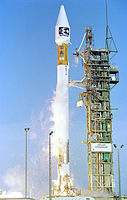 |
| Atlas IIIB | 2002 | 2005 | 4 | 4 | 1xRD-180 | 1xRL10A | Same as Atlas IIIA, except for Centaur stretched 1.7 m and an optional dual engine Centaur. | |
| Atlas V 400 | 2002 | 2022 | 59 | 58 | 1xRD-180 | 1xRL10A | Lunar Reconnaissance Orbiter, LCROSS, Mars Reconnaissance Orbiter |  |
| Atlas V 500 | 2003 | - | 18 | 18 | 1xRD-180 | 1xRL10A | New Horizons, X-37B, Mars Science Laboratory |  |
| Atlas V N22 | 2019 | - | 2 | 1 | 1xRD-180 | 2xRL10A | Starliner Boeing OFT | 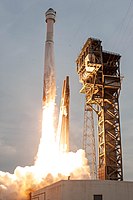 |
RD-180 phaseout
In 2014, US Congress passed legislation restricting the purchase and use of the Russian-supplied RD-180 engine used on the first stage booster of the Atlas V. Formal study contracts were issued in June 2014 to a number of US rocket engine suppliers.
In September 2014, ULA announced that it had entered into a partnership with Blue Origin to develop the BE-4 LOX/methane engine to replace the RD-180 on the new Vulcan rocket. The new stage and engine first flew in 2024.
In December 2014, legislation to prevent the award of further military launch contracts to vehicles that use Russian-made engines was approved by the US Congress. The bill allows ULA to continue to use the 29 RD-180 engines already on order at the time. In September 2021, ULA announced that Atlas V will be retired after they fulfill their remaining launch contracts, and that all remaining RD-180s for the remaining rockets have been delivered.
Formerly proposed launch vehicles
Prior to the April 2015 announcement of the Vulcan launch vehicle, during the first decade since ULA was formed from Lockheed Martin and Boeing, there were a number of proposals and concept studies of future launch vehicles. None were subsequently funded for full-up development. Two of those concepts were the Atlas V Heavy and the Atlas Phase 2.
Atlas V Heavy
Main article: Atlas V § Atlas V HeavyThe Atlas V Heavy was a ULA concept proposal that would have used three Common Core Booster (CCB) stages strapped together to provide the capability necessary to lift a 55,000-pound (25 t) payload to low Earth orbit. ULA stated that approximately 95% of the hardware required for the Atlas HLV had already been flown on the Atlas V single-core vehicles.
A 2006 report, prepared by RAND Corporation for the Office of the Secretary of Defense, stated that Lockheed Martin had decided not to develop an Atlas V heavy-lift vehicle (HLV). The report recommended for the Air Force and the National Reconnaissance Office to "determine the necessity of an EELV heavy-lift variant, including development of an Atlas V Heavy", and to "resolve the RD-180 issue, including coproduction, stockpile, or U.S. development of an RD-180 replacement."
The lifting capability of the Atlas V HLV was to be roughly equivalent to the Delta IV Heavy. The latter utilizes RS-68 engines developed and produced domestically by Pratt & Whitney Rocketdyne.
Atlas V Phase 2
Main article: Atlas V § Atlas V Phase 2After December 2006, with the merger of Boeing and Lockheed-Martin space operations into United Launch Alliance, the Atlas V program gained access to the tooling and processes for 18 ft (5.4 m) diameter stages used on Delta IV. An 18 ft diameter stage could have conceivably accepted dual RD-180 engines. The resulting conceptual heavy-lift vehicle was called "Atlas Phase 2" or "PH2" in the 2009 Augustine Report. An Atlas V PH2-Heavy (three 5 m stages in parallel; six RD-180s) along with Shuttle-derived, Ares V and Ares V Lite, were considered as a possible heavy lifter concept for use in future space missions in the Augustine Report. The Atlas PH2 HLV concept vehicle would have notionally been able to launch a payload mass of approximately 150,000 pounds (70 t) into an orbit of 28.5 degree inclination. The concept did not proceed onto full development, and was never built.
See also
References
- ^ Rusty Barton. "Atlas ICBM Chronology". Archived from the original on 2006-02-04.
- Deny Rocket Lag. Atlas Firing Keynotes U.S. Missile Build-Up, 1959/01/29 (1959). Universal Newsreel. 1959. Retrieved February 22, 2012.
- Helen T. Wells; Susan H. Whiteley & Carrie E. Karegeannes. Origin of NASA Names. NASA Science and Technical Information Office. pp. 8–9.
- "This week in history - Feb. 26, 1954: Air Force awards contract for Atlas ICBM propulsion system". U.S. Air Force. February 28, 2013. Retrieved March 29, 2023.
- "WD-40 History | Learn the Stories Behind the WD-40 Brand | WD-40". www.wd40.com. Retrieved 2022-06-15.
- "Atlas E". Encyclopedia Astronautica. Archived from the original on March 5, 2002. Retrieved 28 October 2014.
- "Project SCORE". Patterson Army Health Clinic. Archived from the original on 2007-06-24.
- "SCORE (Signal Communication by Orbiting Relay Equipment)". GlobalSecurity.org. Retrieved 28 October 2014.
- Video: Atlas In Orbit. Radios Ike's Message Of Peace To World, 1958/12/22 (1958). Universal Newsreels. 1958. Retrieved 20 February 2012.
- ^ "Encyclopedia Astronautica – Atlas A". Astronautix.com. Archived from the original on 22 May 2013. Retrieved 19 July 2013.
- Tariq Malik (August 31, 2004). "Final Atlas 2 Rocket Orbits Classified U.S. Satellite". space.com. Retrieved March 29, 2023.
- Mark Wade. "Atlas/Agena D SLV-3A". Astronautix.com. Archived from the original on August 27, 2002. Retrieved 28 October 2014.
- "Atlas F". spacelaunchnow.me. Retrieved March 29, 2023.
- Krebs, Gunter D. "DMSP-5D2 F6, 7, 8, 9, 10, 11, 12, 13, 14". Gunter's Space Page. Retrieved April 1, 2023.
- "Atlas Vega". Astronautix.com. Archived from the original on August 24, 2016. Retrieved 28 October 2014.
- "Delta A". Astronautix.com. Archived from the original on May 25, 2002. Retrieved 28 October 2014.
- "Atlas-SLV3B Agena-D". Space.skyrocket.de. Retrieved 28 October 2014.
- "Atlas I". Encyclopedia Astronautica. Archived from the original on August 27, 2002. Retrieved 28 October 2014.
- "Space Launch Report: Atlas III Data Sheet". 1 Dec 2005. Archived from the original on 6 Apr 2022.
- "Lockheed Martin Ready For Launch Of Intelsat 14 Spacecraft". Lockheed Martin. November 11, 2009. Archived from the original on 17 December 2011. Retrieved 28 October 2014.
- ^ Roulette, Joey (26 August 2021). "ULA stops selling its centerpiece Atlas V, setting path for the rocket's retirement". The Verge. Retrieved 1 September 2021.
- "Evolved Expendable Launch Vehicle". Afspc.af.mil. March 2009. Archived from the original on 27 April 2014. Retrieved 28 October 2014.
- "ULA Could Buy as Many as 30 More Russian-made RD-180 Engines". SpaceNews. 2015-01-20. Retrieved 2015-04-13.
- Ferster, Warren (2014-09-17). "ULA To Invest in Blue Origin Engine as RD-180 Replacement". Space News. Archived from the original on September 18, 2014. Retrieved 2014-09-19.
- Petersen, Melody (2014-12-12). "Congress OKs bill banning purchases of Russian-made rocket engines". LA Times. Retrieved 2014-12-14.
- National Security Space Launch Report (PDF). RAND Corporation. 2006. p. 29. Retrieved 28 October 2014.
- National Security Space Launch Report (PDF). RAND Corporation. 2006. p. xxi. Retrieved 28 October 2014.
- Atlas V EELV – Lockheed-Martin Retrieved on 2008-02-08. Globalsecurity.org. Retrieved on 2011-11-19.
- ^ "HSF Final Report: Seeking a Human Spaceflight Program Worthy of a Great Nation" (PDF). October 2009. p. 64. Archived from the original (PDF) on 2019-02-16. Retrieved 2011-02-07.
Review of U.S. Human Spaceflight Plans Committee
Further reading
- Gainor, Christopher, "The Atlas and the Air Force: Reassessing the Beginnings of America's First Intercontinental Ballistic Missile," Technology and Culture 54 (April 2013), 346–70.
External links
| Atlas rockets | |||||||||||||||
|---|---|---|---|---|---|---|---|---|---|---|---|---|---|---|---|
| Main articles | 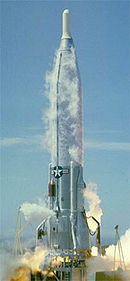 | ||||||||||||||
| Rockets |
| ||||||||||||||
| Launch sites |
| ||||||||||||||
| Components |
| ||||||||||||||
| Corporations |
| ||||||||||||||
| Launches | |||||||||||||||
| USAF and USSF space vehicle designations (since 1962) | |
|---|---|
| SLV series | |
| SB series | |
| Satellites | |
| |
| Rocket families | |||||||||||||||||
|---|---|---|---|---|---|---|---|---|---|---|---|---|---|---|---|---|---|
| Carrier rockets |
| ||||||||||||||||
| Sounding rockets | |||||||||||||||||
| Missiles | |||||||||||||||||
| |||||||||||||||||
| Project Mercury | |||||||
|---|---|---|---|---|---|---|---|
| General |  | ||||||
| Missions |
| ||||||
| Flown non-human | |||||||
| Astronauts |
| ||||||
| Subprograms | |||||||
| Contractors |
| ||||||
| Rockets |
| ||||||
| Launch sites and Control Center | |||||||
| Related programs |
| ||||||
| Related |
| ||||||
